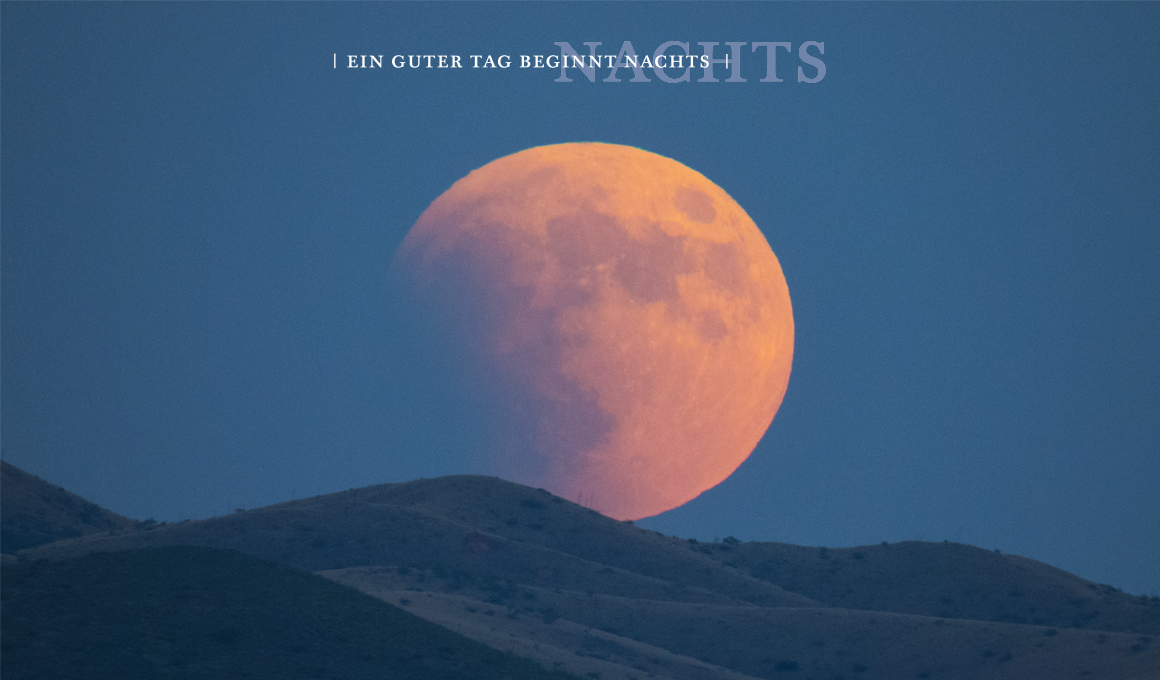Dark red and mysterious, it stands in the night sky. The blood moon is a fascinating celestial event that has always impressed and captivated mankind. But what exactly is behind the phenomenon of the reddish-colored full moon, which is sometimes also called the copper moon? What scientific explanations are there for it? In this article, we will take a closer look at the causes, the historical and cultural significance of the blood moon and its possible effects on human sleep.
What is a blood moon?
A blood moon is the reddish coloration of the full moon that occurs during a total lunar eclipse. This phenomenon occurs when the earth is positioned directly between the sun and the moon, casting its shadow on the full moon. Although the moon is then completely in the Earth’s umbra, it is not “invisible” to our eyes, but appears in a color spectrum ranging from orange to dark red.
How does the reddish coloration come about?
The characteristic red color of the blood moon is caused by the scattering of sunlight in the Earth’s atmosphere. When the sunlight passes through the atmosphere, the shorter wavelengths, i.e. blue and green light, are scattered more strongly than the longer wavelengths with red and orange light. This phenomenon, also known as Rayleigh scattering, means that mainly red light reaches the Earth’s shadow, causing the moon to appear reddish in color.
Does the blood moon affect our sleep?
There are no specific studies that investigate the direct influence of a blood moon on our sleep. Nevertheless, it is known that the full moon can have a general effect on sleep. Some studies suggest that people take longer to fall asleep on full moon nights and experience fewer deep sleep phases. As a blood moon or total lunar eclipse only occurs during a full moon, similar effects could be observed. However, the effects vary from person to person and are not equally pronounced for everyone. If you would like more information on this topic, you can find confirmation in the article Sleep research: Full moon affects sleep for more exciting facts and details.
How often does a blood moon occur?
A lunar eclipse is not an all too rare event. They occur around the world about once or twice a year, but not every one of them is total. On average, a total lunar eclipse can be seen every 2 to 3 years. In some years the event even occurs twice, in others not at all. Although blood moons are relatively common worldwide, they are not visible everywhere. In some regions of the world, a total lunar eclipse may be visible, while in others it may only appear as a partial lunar eclipse or not at all. Whether a blood moon can be seen at a particular location (e.g. in Germany) depends on the moon’s orbit and the position of the Earth.
How long does a total lunar eclipse last?
The duration of a total lunar eclipse varies depending on how deep the full moon plunges into the Earth’s shadow. From start to finish, including all phases in between, a total lunar eclipse lasts around 3 to 5 hours. It begins with the penumbral phase, which lasts about an hour and is not always visible. This is followed by the partial phase, also lasting about an hour, in which the full moon enters the Earth’s umbra. The total phase, i.e. the blood moon, can last between 30 and 100 minutes. This is followed by another one-hour partial phase in which the full moon emerges from the umbra and the one-hour exit from the penumbra.
When will the next blood moon be visible?
Below we have listed the dates of the next blood moons with visibility in Germany:
- 07.09.2025
- 31.12.2028
- 26.06.2029
- 20.12.2029
Viewing conditions can vary depending on the weather conditions and geographical position within Germany. It may therefore be worth consulting astronomical sources and weather services in advance to find out exactly where the moon will be in the sky and what the cloud cover will be like.
What is the best way to observe a blood moon?
You don’t need any special equipment to observe a blood moon. The phenomenon is visible to the naked eye. Unlike a solar eclipse, for example, observing a total lunar eclipse is not dangerous for the human eye. Therefore, no special eye protection is required. However, the use of binoculars or a telescope may be advisable to enhance details and make them easier to see. A clear sky and a location with minimal light pollution offer the best conditions for observation. It is advisable to find out the exact times of the lunar eclipse in advance, as although the event can last for several hours, the total phase of the lunar eclipse, which is particularly impressive, often only lasts for about an hour.
What is the cultural and historical significance of a blood moon?
Superstition and numerous myths surround the blood moon. In many cultures, the blood moon was associated with prophecies, supernatural events and disaster. Some ancient civilizations – such as Ancient Egypt – saw the red full moon as an omen of significant events, such as wars, diseases or natural disasters. In ancient Greece, it was believed that witches unleashed their dark powers during a lunar eclipse and turned the moon an ominous red color.
In China, on the other hand, people told themselves that a mighty dragon roamed the sky and threatened to devour the moon as soon as it darkened. Others believed that during a total lunar eclipse, special forces were at work that could influence human behavior. Nowadays, we understand the scientific background to the phenomenon, but the fascination and symbolic meaning remain in many cultures.
The blood moon in the modern world
Even in modern times, the blood moon has lost none of its fascination. Thanks to social media and global networking, people all over the world can share and experience this special spectacle in the night sky. Photographers take the opportunity to capture impressive images of the red moon. A total lunar eclipse is also still an exciting event for modern science. Among other things, they can study the properties of the Earth’s atmosphere. In art, literature and film, the blood moon has always served as an inspiration and is often used as a symbol of change, mystery or the uncanny.
Even if no direct effects of the blood moon on our sleep are known from a scientific point of view, the anticipation and excitement of the event can still have an effect on our night’s sleep and possibly impair it. In order to be particularly well prepared, we recommend comfortable and suitable bedding that enables a particularly good night’s sleep.
The natural topper VARIOSAN® is filled with 100% virgin sheep’s wool and therefore has excellent temperature-regulating and moisture-regulating properties. Pure new sheep’s wool also has very good self-cleaning properties, which means that the topper remains hygienic and fresh for a long time even without washing.
The NOVUM neck support pillow has a preventative effect against tension. Thanks to three different and variably combinable lying surface elements, the pillow can be individually adjusted in height, softness and support to suit personal needs and wishes. The pillow has a removable cover that can be washed at up to 95 °C and is therefore also suitable for house dust allergy sufferers.
The ALMIRA® down duet ensures cuddly soft, feel-good sleep. The comforter is not only particularly light and cuddly, it also ensures a pleasantly warm and dry sleeping climate thanks to its high breathability and excellent moisture regulation. As individual needs vary, we offer the down comforter in different warmth levels.














